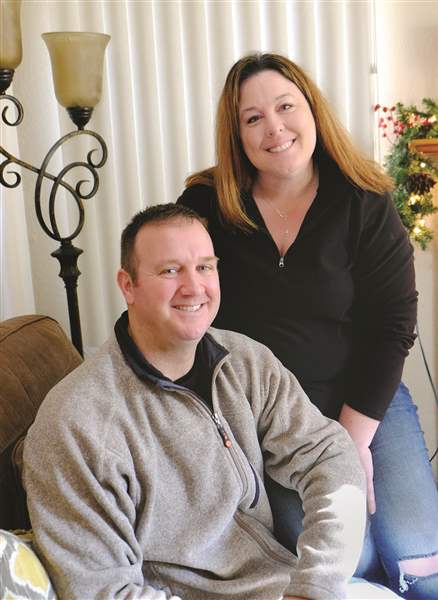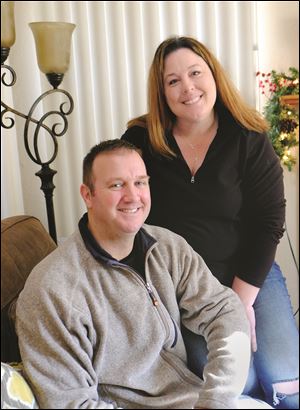
Crowdfunding a popular choice to offset infertility, adoption costs
1/24/2016
Jim and Nikki Cassidy of Toledo are using crowdfunding to help them to pay for the costs of adopting a child.
The Blade/Jetta Fraser
Buy This Image

Jim and Nikki Cassidy of Toledo are using crowdfunding to help them to pay for the costs of adopting a child.
Jim and Nikki Cassidy yearn to hear the laughter of a child in their West Toledo home.
A fall 2005 wedding, countless fertility treatments, an endometriosis diagnosis, a devastating miscarriage, three surgeries in four years, and passage of more than a decade later, the Cassidys are still waiting for those tender giggles and everything else that comes with being a parent.
And they are willing to use an unconventional — but exceedingly more popular — method to help with the exorbitant costs of starting a family when natural means fail.
They are among a groundswell of couples or individuals who have turned to the popular crowdfunding website GoFundMe in the last four years to help allay either infertility treatment or adoption costs.
“There were different surgeries, a lot of medicines trying to [get pregnant] and it came to a point where we pretty much knew it wasn’t going to happen through natural means, so we started looking at adoption,” Mr. Cassidy, 46, said.
In 2014, the couple set up a GoFundMe campaign to try to raise $25,000 to put toward the costs of adopting. The fund-raising progress has been slow for the couple: They have raised $2,250 so far, and most of it was right after they created their personal campaign about 18 months ago.
They are not alone. A search of the northwest Ohio and Southeast Michigan areas on GoFundMe brings up more than two dozen couples or individuals looking for monetary relief on their journey to become parents.
“ … We hate to ask for a hand out but we can’t bring our babies home without your help,” writes Caleb and Melissa DeLoria, a Blissfield couple who started a GoFundMe campaign on Jan. 17 to help with in vitro fertilization procedures at the University of Michigan.
Another Toledo couple chose adoption after three years of trying to start a family. They started their GoFundMe campaign in September and have raised $745.
“This journey has been a winding road. We came to the conclusion that adopting a child is our best option. That being said we need your help! With both prayer, and financial support,” Paul and Michelle Wahtola write.

Neither adoption nor fertility treatment methods is inexpensive, and those going through either usually pay 100 percent out-of-pocket, as insurance coverage is almost non-existent. Independent, domestic adoptions can cost anywhere from $8,000 to $40,000, according to the Child Welfare Information Gateway, a U.S. government-funded adoption information service through the U.S. Department of Health and Human Services.
Infertility treatments can range from a few hundred dollars for each treatment using oral ovulation boosting drugs to about $3,000 to boost ovulation through injections, said Dr. F. Nicholas Shamma, doctor of reproductive endocrinology and infertility at the IVF Michigan Fertility Center.
If those methods don’t work after three attempts, some patients turn to in vitro fertilization, or IVF, a procedure in which the woman’s eggs are collected from her ovaries and fertilized by sperm in a lab before the embryo is implanted back in the uterus. The cost involved with that can be about $12,000 each time, Dr. Shamma said.
About 15 percent of couples (between 7.5 million and 8 million) trying to get pregnant are unsuccessful, a number that is really much higher in reality because it doesn’t include same-sex couples or single people, he said.
He said some patients are already drained of financial resources because they have had multiple procedures done before they even get to his office.
“Out of 100 people who come through our door and need in vitro infertilization, only 50 percent will end up going through the procedure, and the other 50 percent would love to go through the procedure and get pregnant ... but can’t do so because of issues related to financial constraints.”
The doctor, who is president and CEO of the IVF Michigan Fertility Center and its satellite facility, the Toledo Infertility Center in Sylvania, was not personally familiar with patients using crowdfunding to help them financially, but said some of his medical residents knew of patients that have turned to it. Even so, the trend did not surprise him. He said many of his patients already turn to family and friends to help cover costs.
Any help is better than no help, Mrs. Cassidy, 37, says. The couple haven’t tallied up the bills to see what they have spent over the years, but they know the monetary damage is tremendous.
They tried different fertility methods for about two years, including ordering injection shots from England that cost about $800 for a two-week supply while Nikki was being treated in Toledo. The bills stacked up, and discouraged, they gave fertility treatment a break.
At one point in the process, Nikki became pregnant on her own, only to miscarry after two months. It left them both discouraged and optimistic that pregnancy was possible. They started driving to a fertility research center at Wayne State University in Detroit a minimum of twice a week.
The emotional roller coaster continued. In 2011, doctors found a large non-cancerous cyst on Nikki’s right ovary. A diagnosis of endometriosis followed, and they were precluded from participating in any further research at Wayne State. A second cyst surfaced. The surgeries Nikki underwent to remove cysts and eventually to have a hysterectomy last fall came with a $70,000-plus price tag.
Now adoption remains their primary goal. But that meant more money.
Mrs. Cassidy was concerned how they would be perceived, but the yearning to be a parent was stronger.
“I was afraid people will look at it and say ‘you want a child and you can’t even afford it.’ I was afraid people would think we were just looking for a handout,” Nikki Cassidy said. “I was on a site about funding adoptions and a lot of people there were turning to GoFundMe.
“This has worked for so many people, so I thought why not give it a whirl.”
Although he supports her, Jim Cassidy was even more hesitant to ask people for money.
“I understand what my wife wants to do and I want to support it, but it’s hard to open up like that and say ‘hey, can you give me a hand,’” he said.
Some campaign topics are more sensitive, and Mr. Cassidy’s hesitancy is not uncommon, said GoFundMe media director Kelsea Little.
“I think it comes down to how someone personally feels comfortable with it,” she said. “But I would tell people that friends and family are more than willing to chip in for something like that. It’s such an eventful thing in life to start a family.
“Once hopeful parents see us as a trusted platform used by other couples, they see [GoFundMe] as an option.”
Ms. Little said a misconception about GoFundMe is that people randomly donate to campaigns without knowing the person, unless it’s a very high profile campaign that is getting a lot of media play.
“Overall it’s friends and family, and friends of friends [who donate],” she said.
GoFundMe was started in 2010 in San Diego by two men, Brad Damphousse and Andrew Ballester. Their vision was simple, said Ms. Little: Create an online platform for people to raise money for causes that are important to them.
She said the company’s success has skyrocketed in the last few months: a new GoFundMe campaign starts every 18 seconds, and the company this year expanded into other countries, including Canada, New Zealand, and the United Kingdom.
The causes that drive people to GoFundMe are vast. People ask for family and friends to help them pay for the wedding of their dreams, assist with a car purchase, or pay for their beloved pet’s surgery. People request a hand getting back on their feet after a devastating fire or debilitating disease. Campaigns have raised a couple hundred dollars, a couple hundred thousand, and for a very small few, a couple million.
Campaigns surrounding medical issues are the most popular on the site. Since 2012, those starting campaigns to help pay for IVF-related procedures has increased from 80 in 2012 to 516 in 2015. Donors have raised more than $2.7 million for that purpose in those four years, according to figures from GoFundMe.
Adoption figures have skyrocketed even more: 166 campaigns were started in 2012 and 1,030 in 2015. The four years of campaigning for adoption funds have raised more than $6.3 million.
Setting up a campaign is free, but GoFundMe gets 5 percent of all money raised.
Another Toledo couple, Dex and Mandi Phillips, created a GoFundMe account in November to raise half of the $20,000 bill it will cost for Mandi, who was also diagnosed with endometriosis, to undergo IVF treatments.
In an eight-minute video accompanying their campaign, the South Toledo couple ask their family and friends for not only financial support, but prayers as well.
“... What I want is to start a family with Mandi. We bought a home, and my hope was to fill the home with children. Hopefully that is still an option for us,” Dex Phillips says on the video.
The couple have raised $4,170 from 23 donations thus far, including $1,000 and $500 from anonymous donors.
Contact Roberta Gedert at: rgedert@theblade.com or 419-724-6075 or on Twitter @RoGedert.